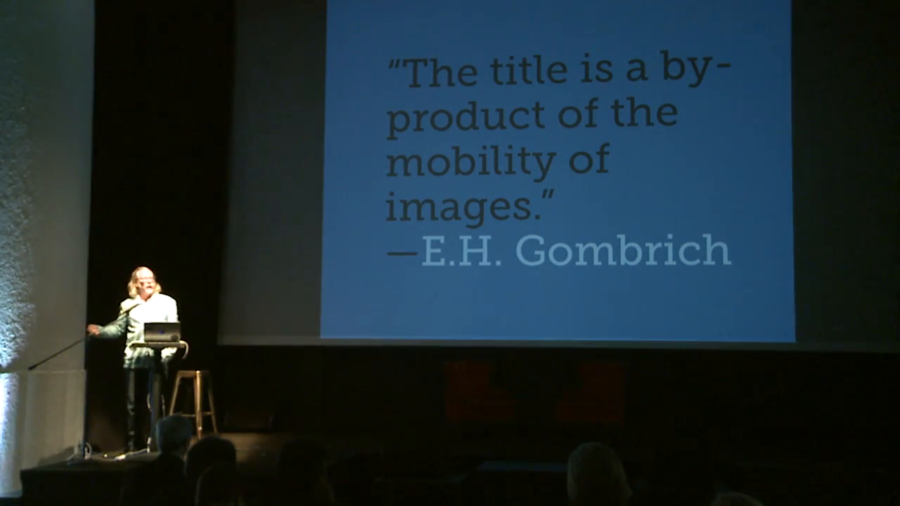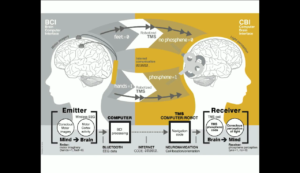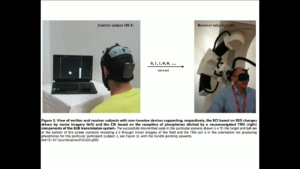Peter Brantley: I just want to punctuate Richard’s talk here because he flew here today from New York, and to be with his kid tomorrow morning he’s flying back tonight. So Richard gets another round of applause.
Richard Nash: Yeah, my daughter’s my current phase of my life. And Books in Browsers used to be a couple of weeks earlier in the year, right around her birthday. And so in some ways my daughter’s absence has always been a part—has always been a presence of this for me. And in the talks that I was able to hear this afternoon, I was thinking about other presences. Not just the history of Books in Browsers itself, which while the subtitle this year may be “Telling Small Stories,” I think you could say that Books in Browsers is an anthology that is culminating to be a very big story, but told humbly. And that’s part of what I think is so important about it.
And it echoes stories of my life of the last twenty years. I published queer comic anthologies when I was a print publisher in the 2000s. And in the 1990s I was an avant garde theater director. And when I walked in this afternoon, I was not expecting to see Anne Bogart’s Viewpoints on a slide at a conference called Book in Browsers. But that’s how special it is. And part of what was so charming for me about that is that the title of my talk is the title of a play. A play by sort of the madman in the attic of the American avant garde theater, Richard Foreman, a play called Film is Evil, Radio is Good, which he wrote in 1987.
And what he was writing about in that play—and his plays are very in a certain sense rarely about anything directly, but we infer what they’re about and it’s obviously quite a provocative statement, and one that I thought could be useful here. And the statement really has to do with viewing the battle between text and image, a battle that is currently being fought in smartphones, but has been fought for basically as long as humans have been making culture and having arguments about how to represent that culture.
When He had finished speaking with him upon Mount Sinai, He gave Moses the two tablets of the testimony, tablets of stone, written by the finger of God.
Exodus 31:18 [presentation slide]
And you know, one of the very very first instances, you might say, of printing were the tablets given to Moses, written by the finger of God. And much as we may feel that books have a kind of spiritual or ecclesiastical dimension, they’re not quite as powerful as two stone tablets.
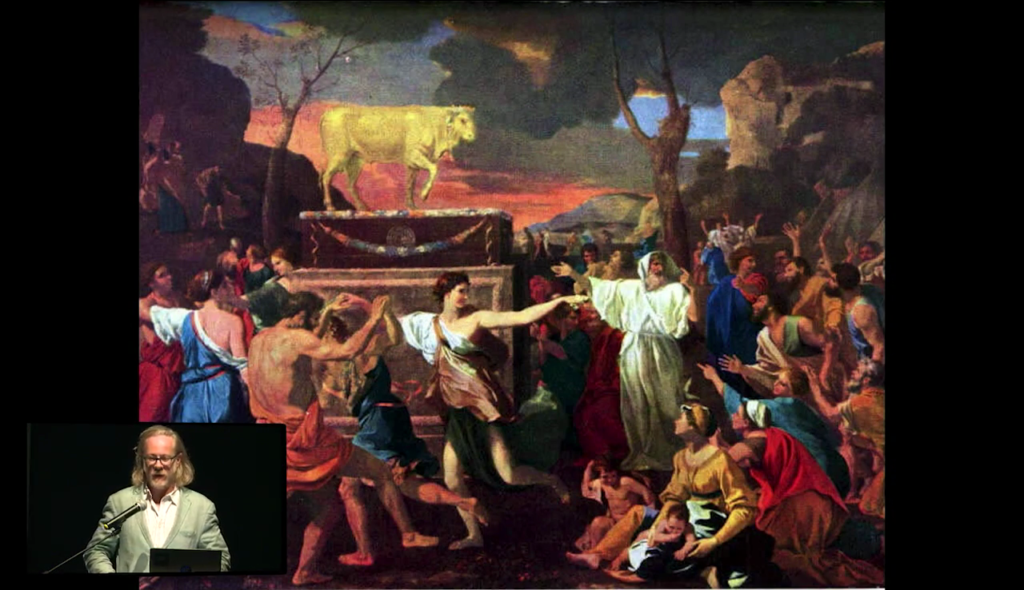
But of course, what was going on while God was giving Moses the ten commandments? Moses’ people were freaking out that he was away, and getting very anxious. And to kind of soothe themselves, sort of like a like a baby’s transitional object, like a blanket, they built themselves a golden calf to venerate. They created an image in lieu of the Word.
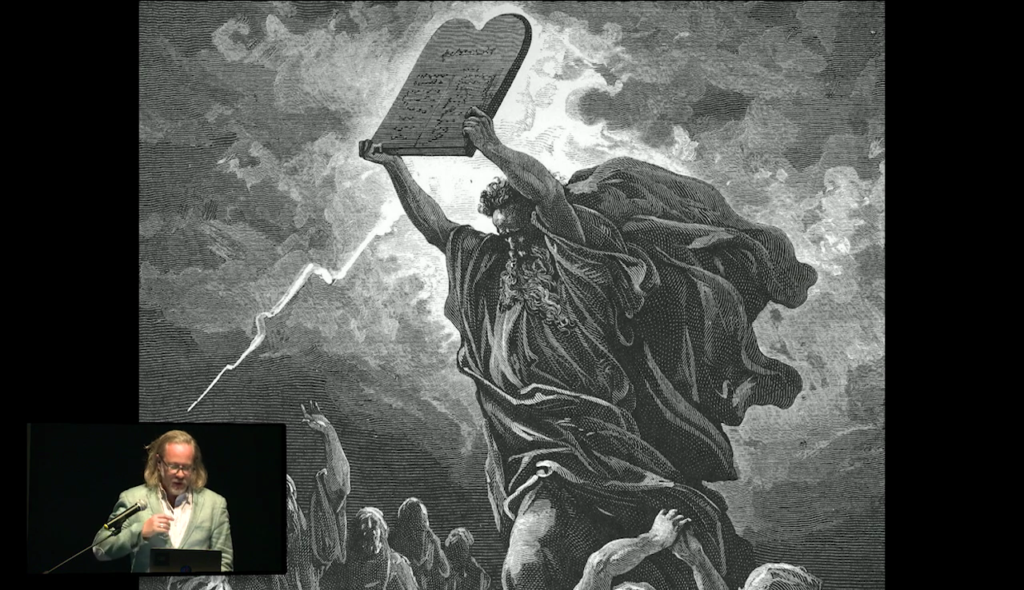
And things did not go well. So, chaos ensued.
Now the LORD said to Moses, “Cut out for yourself two stone tablets like the former ones, and I will write on the tablets the words that were on the former tablets which you shattered.”
Exodus 34:1 [presentation slide]
However God, like any relatively benign publisher, looked ultimately with some grace—if patronizing or even patriarchal grace—upon the audience/flock/author and said, “Well, we’ll do a reprint.” And effectively this is the beginning of iconoclasm, right. This is just Monotheistic Religion #1. The first instance of arguments over how to represent belief, knowledge, culture, how to discuss it, how to interpret it.
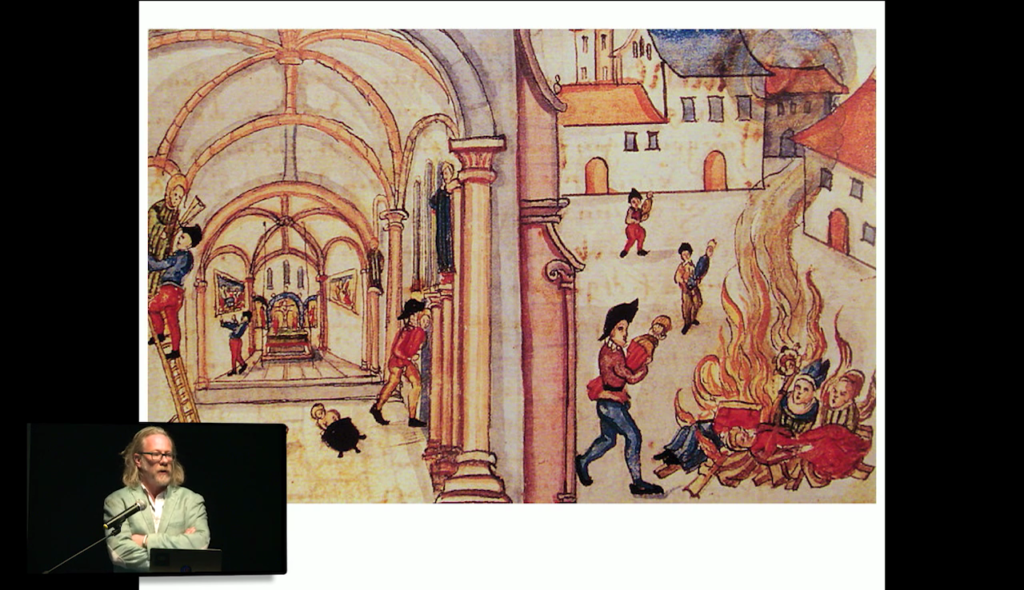
There were a couple of iffy moments. There were a couple of heretical cults in the Byzantine empire that disapproved of all the images. But the next biggie was obviously the Protestant Reformation. Now, what’s interesting about that is that the Protestant Reformation plays a starring role in the history of print, in Elizabeth Eisenstein’s The Printing Press as an Agent of Change, and in our overall understanding of the transformative power of printing, of books, and of text.
But recent scholarship especially has been sort of emphasizing that as important as the ability to produce text without royal or Roman interference was the iconoclastic dimension, the desire to destroy all representations of religious belief. Largely while appearing to be a populist act, ironically it was a bit more of an act of if not the 10%, the 5%. It was basically urban mobs destroying rural churches.
But there was at least in theory a more democratic or a more a bottom-up vision, which was that each individual should be entitled to read the Bible and interpret it for his or her—in that world at the time, mostly his—self. And that the hypothetical power of literacy, of printing, of allowing texts to be made available to anyone to interpret them as they wish, was powerful, was tremendously powerful. Even if in practice it was as much an effort to destroy image as it was to build up text.

And then the third, I think, great wave of iconoclasm is one we’ve witnessed ourselves in the last couple of years, which was the destruction of numerous ruins of Jewish, Christian, Muslim sites in the Near East by ISIS. Islam, the third of the the great monotheistic religions, having engaged to some degree in iconoclastic activities against other religions. The destruction of Hindu temples and of Buddhist temples, but also within—having an argument within, sort of an argument that is in a certain sense Islam’s own internal reformation. But what you have then is in a very very deep world-historical way a conflict that is in a certain sense not dissimilar from SMS vs. Snapchat, glib as that may sound.
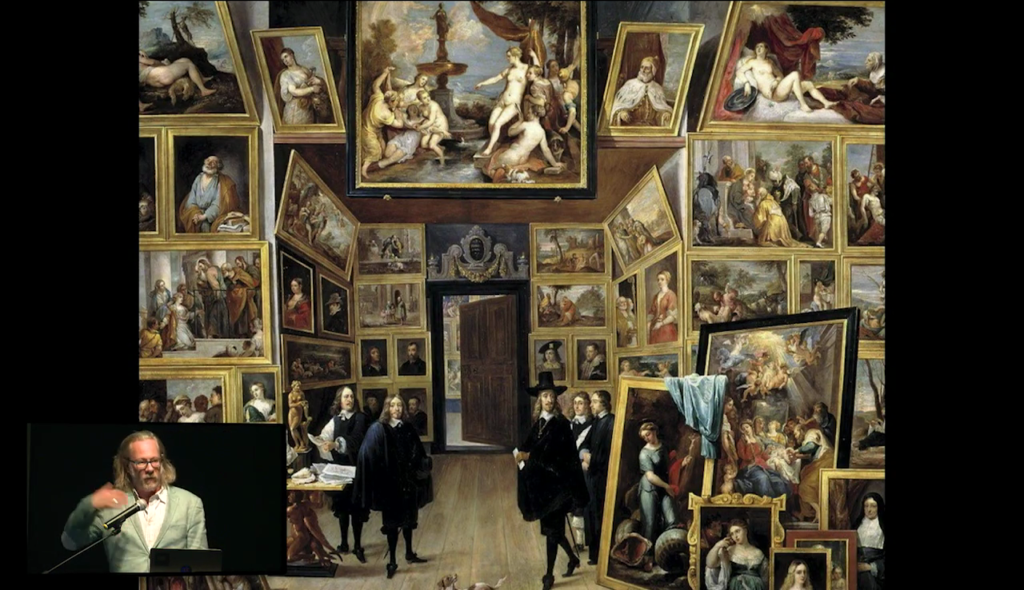
Now, the interesting thing, however, about this sort of somewhat glib opposition between textual and visual representation is that in a number of areas, we have seen them come together. And I think one of the most interesting early examples of that is as painting, as we reached the age of abundance in painting—the age of abundance in painting having begun in the 18th century—one of the interesting things that one had to start to deal with was titling the damn things. Paintings up until the 18th, and even much of the 19th century, had no name. The idea of something being untitled, which is common today, was just the norm. Paintings had no titles.
The title is a byproduct of the mobility of images
E.H. Gombrich [presentation slide]
And titles in painting, as photography comes in to our society in the late 19th century, is the caption. And what you start to see going on here is another kind of way in which arguments about control come into play. And you also begin to realize one of the troubling dimensions of visual representation, which is that it is difficult to critique an image with another image. If you want to argue with, or critique, or undermine, or subvert, or satirize, or question an image, it is very difficult to do so by pairing it with another image. Not impossible, but it is very very difficult. And what we by and large tend to do is pair text with image in order to do that. It’s what we started to do as we started to create more images than we could keep track of.

And as our ability to mechanically reproduce culture went from the printing press to photography to the movie, we encountered the same issue, which is that we made movies that were silent. But it turned out that silent movies on their own didn’t really work. So what did we do before we invented the talkie is we just started adding text.
So again we have another image-only moment that can’t quite sustain itself on its own and has to pull in text in order to be able to sustain itself. And that is a process that has continued up through Web 1.0, and the present era of mobile stories where even Snapchat feels the need to tap to add a caption, or to have hacks around Snapchat that will create unlimited amounts of text.
Yet of course, even within that, if we look at the other sort of image-derived meme of the Internet right now, the emoji, what the emoji we realize begins to do is sort of just take us back to something else that we should always have known, which is that in a certain way text is itself an image. Certainly in the West, where we had the Roman alphabet and twenty-six letters and the imagistic dimension of letters was something largely restricted to poets and artisanal bookmakers. In other cultures, the origins of words in images remain in the alphabet.
And so what I think this begins to suggest for us is that the debate which I followed yesterday on Twitter and today actually a little bit in person—and debate maybe isn’t the right word but the ebb and flow, the sort of whorl of conversation that has been going on here around the relationship both between this older form (the printing press) which was, granted, producing images alongside text but is fundamentally associated with the creation of text, and text as the mode for expressing and disseminating knowledge. And all the other modes of reproduction—first analog, now digital—that are generating images, and observing where the VC dollars from both the North of this particular venue and the South of this particular venue are flowing, they’re tending to flow toward images.
So that rear guard action that effectively begins with God getting really pissed off at the Israelites and has continued in the form of the Calvinists and ISIS, that rear guard action to attempt to obliterate images because they are seductive, because they are uninterrogatable by text, is a tension that we need to be aware of as we play with multimodal, and transmedia, and multimedia, and whatever adjective we’re going to use to describe all these experiments we’re engaged in.
We’re not just sort of comparing technologies, and we’re not just making arguments about neurology. We’re also engaged in an epic multi-civilization argument that I think it behooves us to be aware of as well. And if at any of the foregoing sort of— If there’s any lesson I think to be drawn from the foregoing, it is to say that neither ever wins. By and large images tend to always be in the lead, always running ahead because of ease of consumption, because it requires less brain processing on our parts. But text is never obliterated. It’s a race in which the image is always in the lead and text is always behind, but there is no finish line. There is no point we get to where one or the other is the victor.
[A]ll media, from the phonetic alphabet to the computer, are extensions of man that cause deep and lasting changes in him and transform his environment. Such an extension is an intensification, an amplification of an organ, sense or function.
Marshall McLuhan, “The Playboy Interview: Marshall McLuhan”, Playboy Magazine, March 1969
And if there is in some way some moment at which the fight may not matter anymore, I think it would be interesting to turn to McLuhan for an understanding of of where that might be. And one of the things that McLuhan, especially toward the end of his life and especially in of all places Playboy interview he did in [1969], talked about was to understand that media is effectively an extension of our central nervous system. That they are like a blind man with a cane; the cane effectively becomes part of the body. In other words it starts to be—you sort of see the beginning of what in other conferences might be called the cyborg.
And what I think is the potential endgame for the text vs. image battle is effectively telepathy. And I thought it would be fun to sort of close Books in Browsers with a suggestion that the endgame is in fact no media whatsoever. That the endgame effectively becomes that point in human history, whether 50,000 or 500,000 years from now, when there is no representation. Where ideas not only are not copyrightable but there’s no point in even rendering them in any fixed form, because they’re basically being transmitted from one brain to the other.
And lest this sound utterly ludicrous, the beginnings of technological work is being done around this. There was a test done last year, or eighteen months ago, in which three people in Kerala in India and one person who I think was in Italy transmitted thoughts to one another via the Internet, using brain/computer interfaces on either end. Now, this was as you might imagine incredibly primitive. It basically involved the person speaking, as it were, to think “hand” or “foot” when watching a ball move across a screen. And as he did so, if the ball went up he was supposed to think “hand;” if the ball went down he was supposed to think “foot.” And 8,000 miles away— Or, actually, a 0 or 1 was sent to three people 8,000 miles away. And over the course of 140 bits, two words were spoken, “hola” and “ciao.”
And that is the first recorded human instance of telepathy, hola and ciao. I don’t really have a spectacular closing line with which to end that. So I think I’ll just say hola, and ciao.
Further Reference
Abstract for this talk at the Books in Browsers site.
